The Critical Guide to
the Warren Illustrated Magazines
1964-1983
by Uncle Jack
& Cousin Peter
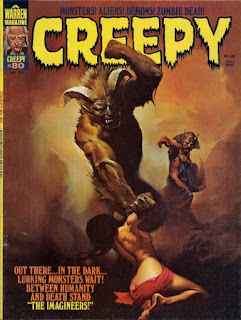 |
| Kelly |
"Benjamin Jones and the Imagineers" ★1/2
Story by Budd Lewis
Art by Luis Bermejo
"Second Genesis" ★
Story by Gerry Boudreau
Art by Esteban Maroto
"The Fable of Bald Sheba and Montebank the Rogue!" ★★
Story by Bill DuBay
Art by Jose Bea
"Proof Positive" ★★1/2
Story & Art by Alex Toth
"Ain't It Just Like the Night" ★1/2
Story by Doug Moench
Art by Martin Salvador
"The Axe-Man Cometh" ★★
Story by Gerry Boudreau & Carl Wessler
Art by Jorge B. Galvez
"The Last Chronicle" ★1/2
Story by Budd Lewis
Art by Jose Ortiz
Young Benjamin Jones is terrified of the things waiting for him outside near the garbage pails; the creatures of the night. Luckily, Benjamin has his toy soldiers, the "Imagineers," who keep him safe when they're by his side. Problem is, Mom wants Benjamin to take the trash out and act like a big boy. The Imagineers must stay in the house!
Benjamin barely makes it back inside after the things attack him but, of course, mother is having none of it. Her son has forgotten to bring the trash can back in and now she insists he scoot back out the door or face the beating of his life. Little Ben begs his mother for a few more moments while his Imagineers ready their defense, but Mom has had enough. She storms out the door to retrieve the pail on her own, vowing that Benjamin's father is going to hear about this. Benjamin locks the door and refuses to open it even after his mother's screams ring through the night.
Owing a huge debt (in my mind at least) to several similar Joe Orlando House of Mystery/House of Secrets stories back in the late 1960s, "Benjamin Jones and the Imagineers" is a jumbled mess with little energy. There's an epilogue after Mom is locked out and her shrieking halts where we see her, in one panel, pouring milk and making cookies for her sweet little boy and, in the next panel, propped up in a chair with her eyes torn out. I'm not sure whether Budd Lewis is reaching for the "Benjamin Jones was insane the whole time and killed his mother" angle or if these monsters really exist. It's a toss-up, I guess. Benjy's mom gets a nice once-over from Ken Kelly in his dynamic cover.
In a future where mice and lizards communicate telepathically with humans, a strikingly illustrated man named Hamlyn decides he really must know who his parents were, so he participates in a government experiment in time travel. Hamyln screws with the gauges and, instead of arriving 100 years in the past, he arrives a mere 30 years before in order to investigate his own birth.
In the past, he bumps into the strikingly illustrated Janella, who thinks nothing of lounging in the nude, and they have a smoldering tryst. Alas, the time cops arrive on the scene and execute Hamlyn for government crimes. The bright side is that he has impregnated Janella with... you guessed it... himself.
Groan. How could new editor Louise Jones not have taken one look at the script for "Second Genesis" and screamed loudly through the Warren office: "No more fucking talking animals!" Seriously, this story is stupid on so many levels that I'm not even going to my thesaurus to look up a fancy four-syllable synonym for stupid. And whoooooooaaaaa, that twist ending is such a shocker, ain't it? Maroto has seen better days as well.
Legend has it that Sheba the Bald Witch was buried with her magical ring, a priceless bauble that every man in the countryside covets. When Montebank the Rogue tries to liberate the corpse of its jewelry, the old hag strangles him and Montebank is cursed to lie with Sheba for all eternity.
Yes, Peregrine (yet another rogue) has heard the legends and believes none of it, but when some of his tankard-lifting mates dare him to visit the grave, the man cannot be kept away. "The Fable of Bald Sheba and Montebank the Rogue!" is paper-thin horror that is saved infinitesimally by Jose Bea's art. In Jose's world, the humans are much creepier than the critters. For me, the biggest kick now to be had from a Bill DuBay story is guessing what crazy combo-title he'll come up with next. Think about it, the selection was endless: "(adjective) (name) and the (adjective) (nonsense word)." With his dictionary by his side, the man was unstoppable!
In 19th Century Baltimore, photographer Barton Dix invents a new form of film development and approaches the patent lawyer firm of Cozzens, Field, and Bryant in an effort to protect his brilliant breakthrough. Barton is dazzled by Bryant's daughter and entrusts the men with his invention. Alas, the three partners are shysters and the "daughter" merely a paid pawn in their charade. Barton overhears the men talking of their deception and invites them to his place for a demonstration of his new process. There, he poisons the three and then develops the film, not knowing how explosive the chemicals can be. BOOM!
At some point in this journey, I'm sure we'll run across a double-duty by Toth where the story is every bit as good as the art, but "Proof Positive" is not that breakthrough. Toth's climaxes, for the most part, have an abruptness to them that is unsatisfying, even while his graphics knock my socks off. The entirety of the story is printed vertically rather than the typical horizontal. Why? Because it's Toth.
A mysterious figure in a trench coat is driving around town, tossing drugged civilians into the back of his van and hauling them off to a deserted warehouse, where he deposits them into huge beakers. WTF? Turns out our perp is actually a good Samaritan alien who's come to Earth to save a handful of humans (and animals) from the upcoming nuclear war that will destroy mankind. After the radiation fades, the BEM will release the survivors and hope they do a better job in the future. We come to find out this is not the first world the grasshopper-creature has saved... and it won't be the last.
Though I thought "Ain't It Just Like the Night" (a superlatively dumb title) was more cliched Warren science fiction nonsense, I thought the Moenchmeister was a sly one when he shifted gears from obvious psycho-killer tale to Noah's Ark/ecology rant. Never saw that coming. The payoff panel, with the weeping insect-head man, didn't elicit the response I assume Doug was looking for. The opening captions, yet another stab by Doug at poetry, I think (Ain't it just like a dream that comes... only when you're blind... ain't it just like insanity to... do only what it thinks is right), made me stop reading a few times and consider another vocation.
Eerie #75
The Spirit #14
With the help of his sister, Cloris, convicted axe-murderer Chester Loomis escapes the four walls of Hargrove Asylum. Cloris takes her brother home to her (incredibly) understanding husband to hide out, but the woman's real motives become clear when she buries a hatchet in hubby's head and calls the police. Chester has the last laugh, though, as he adds Cloris's corpse to the pile and escapes before the cops arrive.
One issue after "Shadow of the Axe" comes the lesser "The Axe-Man Cometh," which wears its pulp roots on its sleeve. It might not be fair to rip into a five-pager that has no script or story to speak of, but that final twist is pretty good. What's not good is the rough and ugly Galvez artwork, where every man looks the same (save a mustache or longer hair) and backgrounds are simply black or white.
Ever since his dearest Charlie sailed away in his patchwork balloon, Bernie sits in his prison and watches out the window, waiting for his friend to return. He finally does. Text-heavy and ponderous, "The Last Chronicle" seemingly exists for the sole reason its first chapter ("The Escape Chronicle" back in Creepy #75) existed: to win Warren Awards. Budd is endlessly satisfied with himself when he pumps out emotional dialogue like "(W)e built an escape machine! Oh God! Oh God, Charlie... Oh God! Didn't we?" In the end, I'm not sure why we needed a second chapter. Bernie seems to seesaw between "Charlie was the greatest thing to ever happen to me" and "Charlie ruined my life." Extra points to Charlie for landing the balloon on the roof of the mental institution with none being the wiser. From top to bottom this was one very boring, very disposable issue of Creepy.-Peter
Jack-I'm not sure which is worse--fewer long stories or more short stories, as we get in this tepid issue. Seven stories that range from five to eight pages in length mean that, when they aren't good, at least they're over quickly. And the stories aren't good this time around. I gave the highest marks to the Toth entry (of course), though it was nothing special and it was really annoying that it was printed sideways. I liked the art on "Benjamin Jones," but the last page makes no sense with Mom being fine in one panel and a corpse in another. I agree that Maroto's work has gone downhill and "Second Genesis" is weak sci-fi with an obvious payoff. Bea's art was too weird for me on the DuBay story, which featured another ending that was telegraphed in advance.
I assume the Moench tale was another file story; I've never been fond of Salvador's art, but the ending was a surprise. "The Axe-Man Cometh" had uneven art and a dopey ending; when I see Wessler as co-writer I figure the other writer had to try to make sense of whatever Carl turned in. Worst of all was "The Last Chronicle"; I had forgotten the earlier story and I wish I could forget this one--it's dull, talky, and pointless. I thought the Louise Jones era was supposed to be good! Not so far...
 |
| Bea |
"The Demons of Jeremiah Cold"★★★
Story by Bill DuBay
Art by Jose Ortiz
"The One Eyed Shall Be King!"★1/2
Story by Budd Lewis
Art by Leopold Sanchez
"Oogie and the Worm!"★1/2
Story by Bill DuBay
Art by Esteban Maroto
"Invasion"★1/2
Story and Art by Jose Bea
"Gillian Taxi and the Sky Pirates"★★
Story by Budd Lewis
Art by Luis Bermejo
Jedediah Pan rides in to the Old West town of Amity, where he enters a saloon and hears a group of men boasting about brutally murdering three young people by crucifying them and peeling the skin from their bodies. Disgusted, Pan decks their leader, a large Native American known as Red Fish, with one punch. A young man named Jeremiah Cold helps Dr. Perry Bottles remove the dead trio from their crosses and Bottles explains that they were all disabled in one way or another. Each lived in the remote, New Mexico town of Kalerville, where those with disabilities are welcomed.
That night, Red Fish and a friend take off from Amity in a biplane (it's1912), intent on machine-gunning the residents of Kalerville from the air. A bloodthirsty mob follows and Pan trails along at a distance to see what happens. When the mob reaches Kalerville, Cold and Bottles fight back, soon to be joined by Pan. Pan is Cold's estranged father and the two must put aside their differences to save the town's residents. Using their magic bracelets, they summon six demons, who quickly destroy the invaders. A brave leap onto the plane's strut by Cold causes it to crash into the side of a mountain. Kalerville is saved and a truce exists between father and son.
"The Demons of Jeremiah Cold" is an example of why I like Warren's longer stories and why I also like the continuing series. The opening of the story was disgusting, but gradually, over twelve pages, it began to make sense, and the end was satisfying. I had to look back at the earlier stories in the series to remind myself of who was who, but once I did I understood what was going on. Ortiz's art is so good that it always elevates any story it illustrates.
The caravan of circus freaks is passing through remote New Mexico when a wheel breaks on a rock. While the wagons are stopped, the freaks are approached by men in hoods and cloaks who demand that they submit to Kaler's judgment. They are brought before Kaler, a strange little bald man who lives inside a glass jar. He insists that the freaks mate with several women he has at hand in order to produce more deformed residents for Kalerville. No way, says Dramulo, who knocks over Kaler's jar, which breaks, killing him. The freaks head down into Kalerville, perhaps finding a home at last.
Any good feelings left behind from the first story are immediately wiped away by this mess, in which Budd Lewis reveals that the kind, accepting town of Kalerville is actually run by a guy from another dimension who is breeding deformed people for his supper. This story is just terrible, though the art is not half bad. The title, "The One Eyed Shall Be King," suggests that the freaks, with all of their problems, have more on the ball than the residents of Kalerville.
Somewhere in the vast reaches of the universe, the robot/computer named Oogie continues to have a man and a woman act out the space opera adventures of Buck Blaster and Thelma Starburst. When a Thelma Starburst spinoff becomes popular, the woman decides she wants liberation and domination, and she and Buck fly off toward Oogie to demand that she be made a god.
Nothing much happens in the ten (endless) pages of "Oogie and the Worm," and Maroto's art continues to underwhelm. DuBay seems to be spinning his wheels with this series and just filling pages. The attempts at humor fall flat.
What seem like tiny aliens discuss their "Invasion" of the human body. In the end, the aliens are revealed to be cancer cells.
This quick five-pager is reprinted from a full-color 1972 book called Dracula that was published by Warren (with a $5.00 price tag!). The book is available to read for free at the Internet Archive, and a comparison of the original pages with the reprint pages shows that the overall story is the same but many of the captions have been rewritten, for no particular reason I can see, and some of the panels have been laid out slightly differently. The punchline is the same. I cannot figure out why the alien from the last panel was used as this issue's cover, especially since they kept it small and surrounded it with vivid pink. It looks like the 1972 book was itself a reprint of a series of comics published in Spain with stories and art by Maroto, Bea, and others.
When Englishman Gillian Taxi invents what appears to be a big, flying teapot that runs on a fuel made from crushed rubies, he invites a couple of his pals over for a successful test drive and then opens a taxi company. The high price of a ticket dissuades most potential customers until an Indian prince arrives and pays for a passage to Pooten-Stan. On the way there, the flying teapot is hijacked by sky pirates, but some heroic work by Taxi saves the day.
I take back what I said about long stories. This one just goes on and on and never amounts to much. The art by Luis Bermejo reminds me of Alex Toth's work in spots, especially the way he draws character's faces, but this is a lot of rot, what ho!-Jack
Peter-I can't, for the life of me, figure out what's going on in "Jeremiah Cold," though I'm sure the whole thing is a lesson in the evils of prejudice. As usual, Bill DuBay's script is a whole bathtub full of doolally, but that goofiness translates into energy, which stimulates the kitsch side of my brain. The splash is about as graphic a concept as you'll see in funny books (gutted and crucified pre-teens is not something you'll see in The House of Mystery), but those graphics, I'm sorry to say, resemble the aftermath of a spilled barrel of entrails. I can't even begin to tell you what's happening on page 14.
I can't help but think that Budd Lewis was striving for some demonic version of Guardians of the Galaxy (or another of the lesser Avengers clones) with his "Freaks." I know my fingers keep typing the same sentences when it comes to the Lewis/DuBay dialogue in these things but, Kee-rist, no one, not even winged freaks, spout dopey lines like "I can't keep from wondering why I'm not normal, Anglo-Saxon, Protestant, married with two kids and reading the paper at the breakfast table in a Boston brownstone!" My eyes are so tired from rolling.
"Oogie and the Worm" is an overlong mash-up of bad sci-fi and groan-inducing one-liners, easily the worst thing I read this month. "Invasion" is short and the climactic twist is pretty good, but I had the sneaking feeling that the captions didn't go with the pictures. At 16 pages, "Gillian Taxi" is entirely too long but at least it's a whimsical fantasy adventure in a sea of bad science fiction.
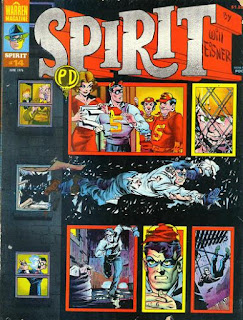 |
| Eisner |
"Dick Whittler" (7/23/50)
Story & Art by Will Eisner
"The Chase" (7/30/50)
Story by Jules Feiffer & Will Eisner
Art by Will Eisner
"Investigation" (8/6/50)
"Sammy and Delilah" (3/5/50)
Story & Art by Will Eisner
"A Day at the Zoo" (4/23/50)
Story by Jules Feiffer
Art by Jules Feiffer & Will Eisner
"Teacher's Pet!" (9/10/50)
Story & Art by Will Eisner
"The Hero" (5/13/51)
Story by Will Eisner & Jules Feiffer
Art by Klaus Nordling & Jim Dixon
"The Big Win" (10/1/50)
Story & Art by Will Eisner
"The First Man" (8/20/50)
Story by Jules Feiffer
Art by Will Eisner
Jack-A solid but not outstanding group of reprints fill this issue. With nine stories at seven pages each, there are 63 pages of comics included, quite a bit more than the 49 pages in Creepy and Eerie. Of course, these are reprints, but I think Eisner was doing touchups and revisions, so it's quite a bargain.
The first three stories make up one long narrative. "The Chase" is the strongest, with its great evocation of a seedy roadside diner where the flies outnumber the customers. The character of "Dick Whittler" is engaging and the first story has a nice cliffhanger ending. The third story, where all is explained, is a bit of a letdown, but Eisner sure can draw action scenes.
The next two stories are character studies where the Spirit barely appears. "Sammy and Delilah" is a clever parody where the temptress appeals to the boy's stomach rather than his lust (which is nonexistent), while "A Day at the Zoo!!" is most notable for Feiffer and Eisner's extraordinary skill at depicting rain on paper. "Teacher's Pet!" features the always-welcome P'Gell and the return of Dick Whittler, along with a funny bit where the Spirit masquerades as a college student to the delight of every co-ed in sight.
"The Hero" is drawn by Klaus Nordling and Jim Dixon, and their art is virtually indistinguishable from Eisner's. The last two stories are the weakest and "The First Man" seems to recycle a plot device we've seen before, with a nobody determined to be the first to pass through a new tunnel.
Peter-Overall, this is one of the lesser issues of The Spirit I've read, with a lot of humdrum scripts and forgettable supporting characters. I liked the goofiness of "A Day at the Zoo!!" but, of course, I was rooting for the lion. The art on the three-parter that opens the issue looks rushed, as if Eisner didn't have the time to complete the usual detailed backgrounds, moody splashes, and dark inks. Perhaps Jim Warren and Will Eisner had already mined all the classic material for the early issues.
 |
| Next Week... Who is Nocturna? |











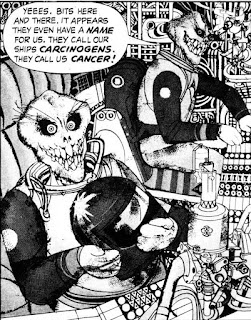

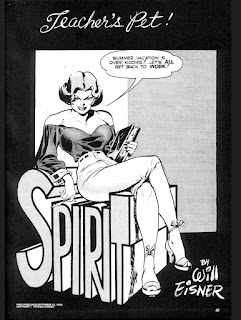
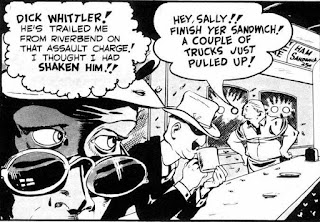
Maybe I remember it incorrectly, but I think there's a real "WTF" moment in "Gillian Taxi" involving one of the "good guys" and cat. Not so much a dark one as a real "What were they THINKING?" kind of dark one. Or maybe it was one of the bad guys, I'm not sure.
ReplyDeleteEven though I'm not exactly sentimental about it, I've always tried to identify the story about a woman taking in her fugitive brother so she can pin her husband's murder on him ("The Axe-Man"), so now this clears that up.
You're right! The main character discovers a cat on his ship, so he shoots and kills it. Problem solved. Maybe the writer did not like cats.
ReplyDeleteCreepy #80 is one of the earliest Warren magazines I ever read so I do have a certain level of nostalgia about it and was more positive towards most of the stories than you were. "Benjamin Jones and the Imagineers" reminds me of when I was a kid and had to take out the trash at night and how scared I was about it! "Second Genesis" I recall enjoying a lot when I first read it, and loved the Maroto art although in time I realized his art is actually quite weak on this story in comparison to his usual work. I'm pretty sure "Bald Sheba" is the last original Jose Bea story we'll get, which is quite unfortunate as he's always been a very memorable artist for me. We will at least get a few more stories from him that Warren grabbed from other sources and reprinted including the later "Invasion". This story's ending I've seen in several places including the "Scary Stories to Tell in the Dark" book series and an episode of the original Twilight Zone. I believe "Proof Positive" is the first Warren story to be printed sideways, something we'll see from time to time going forward, most commonly on Esteban Maroto drawn stories. "Ain't it Just Like the Night" has got to be an inventory story since Moench is long gone at this point, but it was a pretty good one that I enjoyed. "Axe Man Cometh" was a decent, albeit overly gory story. "The Last Chronicle" is a meandering and totally unneeded story which bored me so much that I stopped reading it part way and gave up. They shouldn't have ever bothered with a sequel for a story that was already kind of overrated.
ReplyDeleteThis issue of Eerie has got to give us one of the strangest Warren covers of all time! Also rather cheap on Warren's part by simply coloring a reprinted panel instead of buying a painting. I recall them doing that several years back shortly after Dubay first became editor. The latest Jebediah Pan story is a fairly good one, and interesting idea with them continuing on with the concept of Kalerville into the next story, despite the different writer. A very weird story to conclude The Freaks story, but I enjoyed the absurdity of it. "Oogie" continues to be a poorly written series that makes me wonder if Maroto provided the art first and Dubay came up with some alternative story for things. Maroto's art continues to not be as good as he can be, although I do like the surrealist nature of much of it. "Invasion" was a decent enough story if for only how strange the artwork was. I've got the entire 12 issue run of Dracula that was made available in English (Warren only made the first 6 issues available but a different British publisher translated and brought over 6 more issues as well) and covered them on my blog a few years back. Bea provides a lot of interesting and extremely bizarre stories. I wish they chose a different story than this one as there's a lot better stuff than this. "Gilliam Taxi" I dreaded reading upon realizing how long it was and that there's no horror to it whatsoever (although I too was very disturbed by the cat murder!). It wasn't as bad as I thought it may be, but the fact that Eerie is giving us a fantasy story and not a horror one annoys me. Not too much longer until we've got another mediocre Bermejo-drawn series clogging up much of Eerie's pages in The Rook.
What is your blog?
ReplyDelete